Moon Phase Calendar for 2025
Today's Moon is 27% of Full and 25 days old.
What's the Moon's phase today? With our 2025 Moon Phase Calendar, you'll find the current Moon phase for tonight—plus, all the phases of the Moon for each day of the month.
- We also highlight the date and time for the four main Moon phases—the new Moon, first quarter, full Moon, and last quarter Moon—as well as provide daily Moon illumination percentages and the Moon's current age.
- Unlike many tools, this Moon Phase Calendar is customized to YOUR zip code. No manual converting to your local time!
- Looking for past or future Moon Phases? Find your daily Moon Phase going back to 1970 and forward through 2037.
Related links:
ADVERTISEMENT
Moon Phase Calendar for May 2025 for Dublin, NH
| SUN | MON | TUE | WED | THU | FRI | SAT |
|---|---|---|---|---|---|---|
1  Waxing crescent 4 days | 2  Waxing crescent 5 days | 3  Waxing crescent 6 days | ||||
4  First Quarter 7 days | 5  Waxing gibbous 8 days | 6  Waxing gibbous 9 days | 7  Waxing gibbous 10 days | 8  Waxing gibbous 11 days | 9  Waxing gibbous 12 days | 10  Waxing gibbous 13 days |
11  Waxing gibbous 14 days | 12  Full Flower Moon 15 days | 13  Waning gibbous 16 days | 14  Waning gibbous 17 days | 15  Waning gibbous 18 days | 16  Waning gibbous 19 days | 17  Waning gibbous 20 days |
18  Waning gibbous 21 days | 19  Waning gibbous 22 days | 20  Last Quarter 23 days | 21  Waning crescent 24 days | 22  Waning crescent 25 days | 23  Waning crescent 26 days | 24  Waning crescent 27 days |
25  Waning crescent 28 days | 26  New Moon 0 days | 27  Waxing crescent 1 day | 28  Waxing crescent 2 days | 29  Waxing crescent 3 days | 30  Waxing crescent 4 days | 31  Waxing crescent 5 days |
| Moon Phase | Date | Time of Day |
|---|---|---|
| First Quarter | May 4 | 9:53 A.M. |
| Full Moon | May 12 | 12:58 P.M. |
| Last Quarter | May 20 | 8:00 A.M. |
| New Moon | May 26 | 11:04 P.M. |
All times in Eastern time.
About the Moon's Phases
What Are Moon Phases?
As the Moon orbits around Earth and Earth orbits around the Sun, the angle between the Sun, Moon, and Earth changes. As a result, the amount of sunlight that reflects off the Moon and travels to our eyes changes every day. (The Moon itself produces no light of its own.)
We see the Moon’s disk change from all dark to all light to all dark again: This span of time is called a lunar cycle, lunation, lunar month, or synodic month. The length of the cycle can vary slightly, but on average, it is 29.53059 days. (See “What’s the Moon’s Age?” below for more information.)
Astronomers have broken down this cycle into four primary Moon phases: New Moon, First Quarter, Full Moon, and Last Quarter. There are also four secondary phases: Waxing Crescent, Waxing Gibbous, Waning Gibbous, and Waning Crescent. The primary phases occur at a specific moment, no matter where you are on Earth, which is then converted to local time. (Depending on where you live, you may or may not be able to see the exact moment of a phase, in part because the Moon may not have risen yet in your area.) The secondary phases, however, represent a span of time rather than a specific moment.
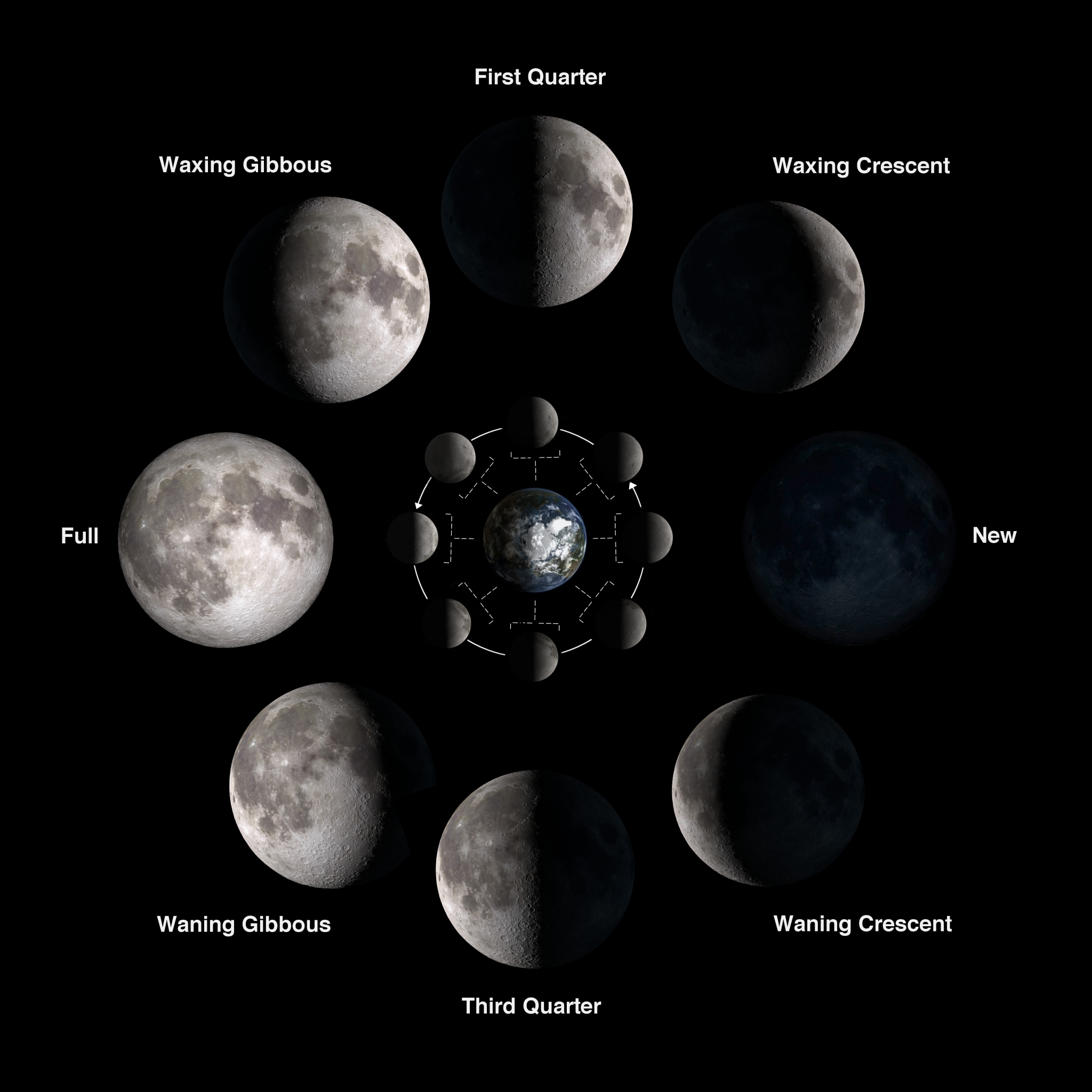
ADVERTISEMENT
• New Moon
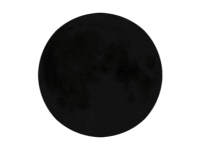
This phase is named as such because it starts a new lunar cycle. At this time, the Sun and Moon are in conjunction, meaning that they are closest together in the sky, on the same side of Earth (Sun→Moon→Earth). From our perspective, the Moon appears totally dark: We can not usually see it because we are facing the Moon’s shadowed side, which does not receive any direct sunlight. But if we were to travel to the other side of the Moon, the part that faces the Sun, it would be totally illuminated.
Occasionally, if the new Moon’s position lines up correctly between the Sun and Earth, from our viewpoint it will cover part or all of the Sun’s disk, causing a solar eclipse. These events are only visible from a small portion of Earth and require special eye protection to be viewed safely. (Read more about solar eclipses here!)
The months of some calendars, such as the Chinese lunisolar calendar, begin at the time of the new (or dark) Moon.
• Waxing Crescent
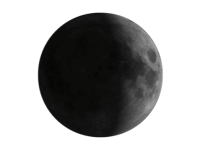 This phase occurs between the new Moon and first quarter phases. At the beginning of this stage, we see a thin, crescent-shape Moon, which, in the Northern Hemisphere, appears on the right side. The lit area slowly widens each day, covering more and more of the right side of the Moon’s surface until the first quarter phase, when the Moon’s entire right side is illuminated. (In the Southern Hemisphere, the same thing happens, only on the left side.)
This phase occurs between the new Moon and first quarter phases. At the beginning of this stage, we see a thin, crescent-shape Moon, which, in the Northern Hemisphere, appears on the right side. The lit area slowly widens each day, covering more and more of the right side of the Moon’s surface until the first quarter phase, when the Moon’s entire right side is illuminated. (In the Southern Hemisphere, the same thing happens, only on the left side.)
Some lunar and lunisolar calendars, such as the Islamic (or Hijri) calendar, define the start of a month as when the Moon first becomes visible, which is usually a day or so after the new Moon, during its waxing crescent stage.
• First Quarter
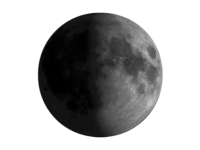 This phase got its name because at this point the Moon has traveled 1/4 of the way through its orbit. It’s a confusing label, though, because at this time from our perspective, 1/2 of the Moon’s surface is lit. In fact, both the first and last quarter phases are sometimes called a Half Moon. At first quarter in the Northern Hemisphere, the right side of the Moon is illuminated; in the Southern Hemisphere, it’s the left side. In actuality, we are seeing 1/2 of the lit side of the Moon because the entire illuminated surface is only partly facing our direction. In other words, the Moon is perpendicular to the Earth/Sun line. During a first quarter phase, the Moon is said to be at east quadrature, meaning that it is 90 degrees east of the Sun when viewed from Earth.
This phase got its name because at this point the Moon has traveled 1/4 of the way through its orbit. It’s a confusing label, though, because at this time from our perspective, 1/2 of the Moon’s surface is lit. In fact, both the first and last quarter phases are sometimes called a Half Moon. At first quarter in the Northern Hemisphere, the right side of the Moon is illuminated; in the Southern Hemisphere, it’s the left side. In actuality, we are seeing 1/2 of the lit side of the Moon because the entire illuminated surface is only partly facing our direction. In other words, the Moon is perpendicular to the Earth/Sun line. During a first quarter phase, the Moon is said to be at east quadrature, meaning that it is 90 degrees east of the Sun when viewed from Earth.
• Waxing Gibbous
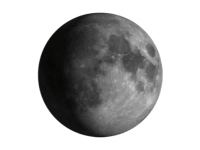 This phase occurs between the first quarter and the full Moon and describes the Moon when it is more than half-lit but not yet fully. At the beginning of this stage in the Northern Hemisphere, we see the right half of the Moon illuminated, plus a tiny fraction more extending into the left side. As the days pass, the light creeps farther left, covering more and more of the Moon’s surface until the full Moon phase, when the entire disk is illuminated. In the Southern Hemisphere, the same happens, only from left to right.
This phase occurs between the first quarter and the full Moon and describes the Moon when it is more than half-lit but not yet fully. At the beginning of this stage in the Northern Hemisphere, we see the right half of the Moon illuminated, plus a tiny fraction more extending into the left side. As the days pass, the light creeps farther left, covering more and more of the Moon’s surface until the full Moon phase, when the entire disk is illuminated. In the Southern Hemisphere, the same happens, only from left to right.
“Gibbous” comes from a Latin word meaning “humpbacked,” referring to the curved lit area on the Moon’s surface.
• Full Moon
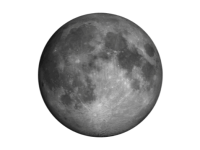
This phase is named as such because, from our perspective, the full disk is illuminated. At this time, the Sun and Moon are in opposition, meaning that they are farthest apart in the sky, on opposite sides of Earth (Sun→Earth→Moon).
Occasionally, if the full Moon’s position lines up correctly with the Sun and Earth, from our viewpoint, the Moon will enter the Earth’s shadow, which will cut off part or all of the sunlight reflected off the Moon’s surface, thereby causing a lunar eclipse. (Learn more about lunar eclipses here!)
• Waning Gibbous
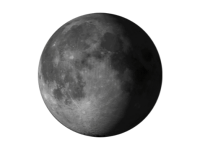 This phase occurs between the full and last quarter and describes the Moon when it is more than half-lit but not fully. At the beginning of this stage in the Northern Hemisphere, we see a disk almost fully lit except for a tiny sliver on the right side that is in darkness. As the days pass, the lit area shrinks from right to left until the last quarter phase, when the Moon’s left half is illuminated and the right half is in darkness. In the Southern Hemisphere, the same happens; only the light shrinks from left to right.
This phase occurs between the full and last quarter and describes the Moon when it is more than half-lit but not fully. At the beginning of this stage in the Northern Hemisphere, we see a disk almost fully lit except for a tiny sliver on the right side that is in darkness. As the days pass, the lit area shrinks from right to left until the last quarter phase, when the Moon’s left half is illuminated and the right half is in darkness. In the Southern Hemisphere, the same happens; only the light shrinks from left to right.
• Last Quarter
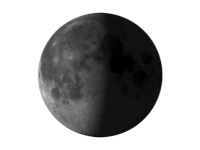 This phase got its name because, at this point, the Moon has traveled 3/4 of the way through its orbit and has just one more (the last) quarter to complete one revolution. This stage is sometimes also called the Third Quarter. At this stage, we see 1/2 of the Moon’s surface lit. In the Northern Hemisphere, the left side is illuminated; in the Southern Hemisphere, it is the right side. During a last quarter phase, the Moon is said to be at the west quadrature, meaning that it is 90 degrees west of the Sun when viewed from Earth.
This phase got its name because, at this point, the Moon has traveled 3/4 of the way through its orbit and has just one more (the last) quarter to complete one revolution. This stage is sometimes also called the Third Quarter. At this stage, we see 1/2 of the Moon’s surface lit. In the Northern Hemisphere, the left side is illuminated; in the Southern Hemisphere, it is the right side. During a last quarter phase, the Moon is said to be at the west quadrature, meaning that it is 90 degrees west of the Sun when viewed from Earth.
• Waning Crescent
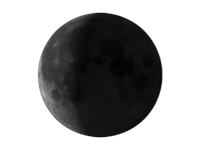 This phase occurs between the last quarter and new Moon phases. At the beginning of this stage, in the Northern Hemisphere, we see the Moon’s entire left side almost fully lit and the right side in darkness. The lit area slowly shrinks each day, covering less and less of the Moon’s surface until it looks like a very thin crescent on the left side. Eventually, the entire disk will be in darkness, at which point it will be the new Moon phase, and another lunar cycle will have begun. (In the Southern Hemisphere, the same thing happens; only the lit area would have started on the right side and shrunk from left to right until a thin crescent remained on the right.) Once the Sun rises, it is not easy to see this slim phase; the best time is before the glare of sunrise.
This phase occurs between the last quarter and new Moon phases. At the beginning of this stage, in the Northern Hemisphere, we see the Moon’s entire left side almost fully lit and the right side in darkness. The lit area slowly shrinks each day, covering less and less of the Moon’s surface until it looks like a very thin crescent on the left side. Eventually, the entire disk will be in darkness, at which point it will be the new Moon phase, and another lunar cycle will have begun. (In the Southern Hemisphere, the same thing happens; only the lit area would have started on the right side and shrunk from left to right until a thin crescent remained on the right.) Once the Sun rises, it is not easy to see this slim phase; the best time is before the glare of sunrise.
ADVERTISEMENT
What Is the Moon’s Age?
The term "Moon's age" is not a reference to how long the Moon has existed (about 4.5 billion years, if you're wondering), but rather how many days it's been since the last new Moon. As mentioned above, the span of time between one new Moon and the next is called a lunar cycle, lunation, lunar month, or synodic month and on average lasts for 29.53059 days. This translates to 29 days, 12 hours, 44 minutes, and 3 seconds.
For most dates in the above Moon Phase Calendar, there is listed at the bottom of the grid cell a number of days, such as “18 days.” This tells us the amount of days since the previous new Moon, or in other words, how many days into the lunar cycle we are—aka, the Moon's age. So, at the new Moon, that day is “0” (not labeled); the next day, 1 day has passed; and onward until 29 days pass and we are at the next new Moon. You can also find this information in the print edition of The Old Farmer’s Almanac, in the last (right) column of the Left-Hand Calendar Pages.
The length of a lunar cycle can vary by more than 13 hours due to a few factors. For example, when the new Moon phase occurs at about the same the time as perigee (the point in the Moon’s elliptical orbit that is closest to Earth), shorter lunations result. When the new Moon phase occurs at about the same time as apogee (when the Moon is farthest from Earth), longer lunations result. This is related to the fact that the Moon travels faster in its orbit at perigee and slowest in its orbit at apogee.
Earth’s relative position near perihelion (point in Earth’s orbit that is closest to the Sun) and aphelion (when Earth is farthest from the Sun) also affect lunation times. The longest lunations result when the new Moon coincides with apogee, and Earth is at perihelion. The shortest lunations result when the new Moon coincides with perigee, and Earth is at aphelion.
One of the shortest lunations was 29 days, 6 hours, and 35 minutes, whereas one of the longest was 29 days, 19 hours, 55 minutes.
Note: The synodic month describes the time for the Moon to complete one orbit around Earth and return to the same position relative to the Sun and Earth. If Earth were not moving along in its orbit but instead were standing still, the Moon would take less time to reach that same position. This is called the sidereal month, which is about 2.21 days shorter than the synodic month. “Sidereal” means “related to stars”—in this case, the Moon’s position relative to the stars.
What Is Percent Illumination?
Percent illumination, listed in the Moon Phase Calendar under the Moon symbol, tells us how much of the Moon’s disk is lit, as seen from Earth. Looking at the calendar on this page, you can see that from new to full, the percentage increases, indicating the waxing stages, and from full to new, the percentage decreases, indicating the waning stages. The New Moon is 0 percent illuminated (or totally dark); the First Quarter is essentially 50 percent illuminated (half of the disk is lit); the Full Moon is 100 percent illuminated (the entire disk is lit); and the Last Quarter is back to essentially 50 percent illuminated (half of the disk is lit).
We say “essentially” for the quarter phases because technically, at the exact time of the first quarter, a tiny fraction more than half of the Moon is lit, and in the last quarter, a tiny fraction less. The Moon is exactly half-lit when it reaches dichotomy, which occurs several minutes before the first quarter and several minutes after the last quarter.
When Does the Moon Rise and Set?
Below are general guidelines as to where to look for the Moon during each of its phases. Times mentioned are solar time, not clock time. The four primary phases (in italics) rise and set at a point in time; the four secondary phases occur over a broader timespan.
| Phase | Rises Near the East | Highest in the Sky | Sets Near the West |
|---|---|---|---|
| New Moon | Around sunrise | Around noon | Around sunset |
| Waxing Crescent | Between sunrise and noon | Afternoon | Between sunset and midnight |
| First Quarter | Around noon | Around sunset | Around midnight |
| Waxing Gibbous | Between noon and sunset | Evening | Between midnight and sunrise |
| Full Moon | Around sunset | Around midnight | Around sunrise |
| Waning Gibbous | Between sunset and midnight | Early morning | Between sunrise and noon |
| Last Quarter | Around midnight | Around sunrise | Around noon |
| Waning Crescent | Between midnight and sunrise | Morning | Between noon and sunset |
What Is Earthshine?
Earthshine is sunlight that dimly illuminates the dark part of the Moon’s surface that faces us. It occurs when light travels from the Sun to Earth, reflects off the Earth, travels to the Moon, and then bounces back to Earth to reach our eyes. When this happens, we can see part of the Moon that normally isn’t lit, but this portion is much dimmer than the section directly illuminated by sunlight.
For example, during a waxing crescent stage, we might see a thin crescent brightly lit by direct sunlight, but also the rest of the Moon’s disk slightly illuminated by a much dimmer glow from Earthshine. Sometimes, this appearance is called the “old Moon in the new Moon’s arms.”
Earthshine is most noticeable within five days of a new Moon (during the waning and waxing crescent stages).
United States of America
- Alabama
- Alaska
- Arizona
- Arkansas
- California
- Colorado
- Connecticut
- Delaware
- District of Columbia
- Florida
- Georgia
- Hawaii
- Idaho
- Illinois
- Indiana
- Iowa
- Kansas
- Kentucky
- Louisiana
- Maine
- Maryland
- Massachusetts
- Michigan
- Minnesota
- Mississippi
- Missouri
- Montana
- Nebraska
- Nevada
- New Hampshire
- New Jersey
- New Mexico
- New York
- North Carolina
- North Dakota
- Ohio
- Oklahoma
- Oregon
- Pennsylvania
- Rhode Island
- South Carolina
- South Dakota
- Tennessee
- Texas
- Utah
- Vermont
- Virginia
- Washington
- West Virginia
- Wisconsin
- Wyoming
